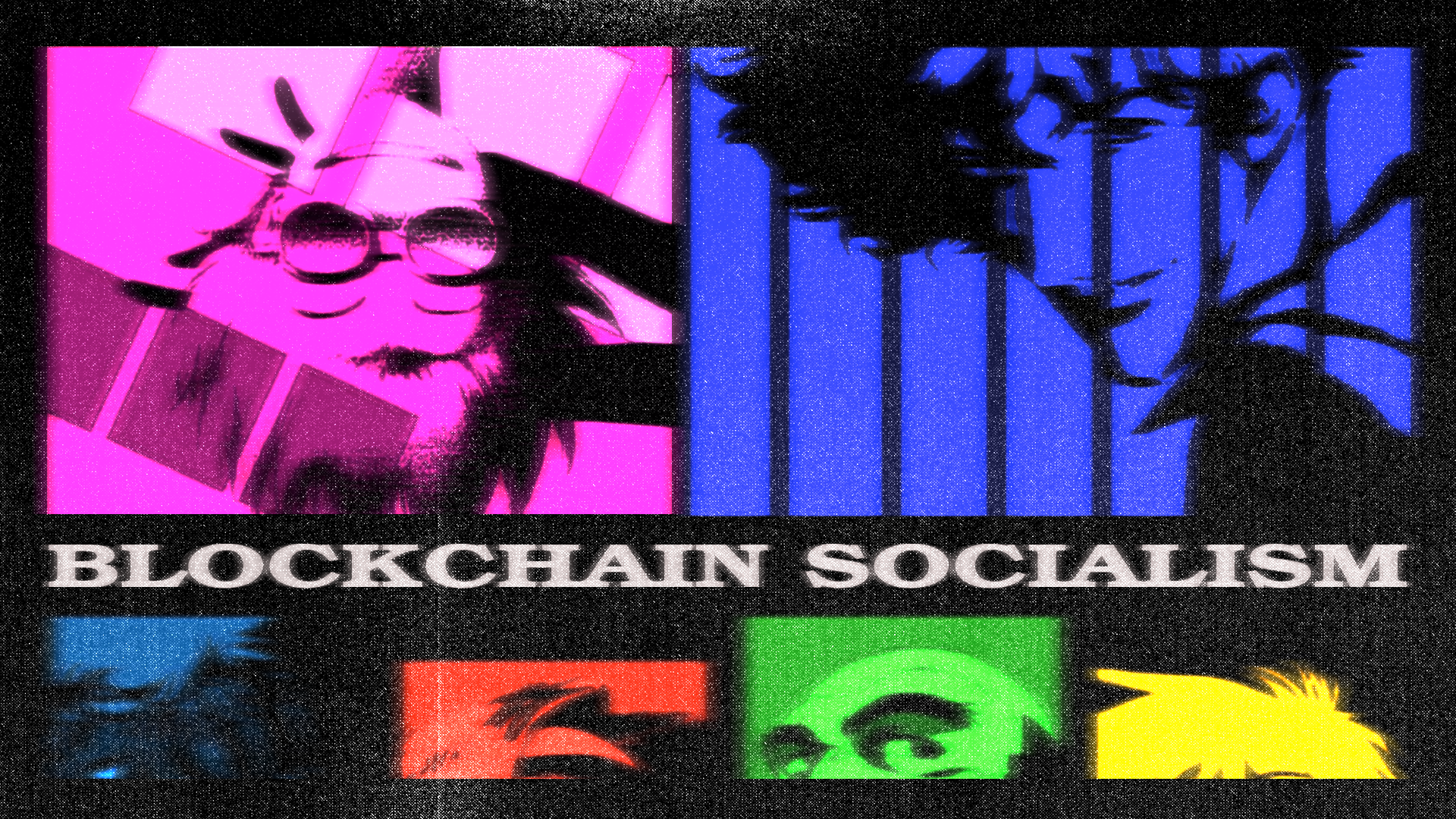- Ariel LeBeau
- Austin Robey
- David Blumenstein
- David Ehrlichman
- David Kerr
- Devon Moore
- Dexter Tortoriello
- Drew Coffman
- Drew Millard
- Eileen Isagon Skyers
- FWB Staff
- Greg Bresnitz
- Greta Rainbow
- Ian Rogers
- Jessica Klein
- Jose Mejia
- Kelani Nichole
- Kelsie Nabben
- Kevin Munger
- Khalila Douze
- Kinjal Shah
- Lindsay Howard
- Maelstrom
- Marc Moglen
- Marvin Lin
- Mary Carreon
- Matt Newberg
- Mike Pearl
- Moyosore Briggs
- Nicole Froio
- Ruby Justice Thelot
- Simon Hudson
- Steph Alinsug
- The Blockchain Socialist
- Willa Köerner
- Yana Sosnovskaya
- Yancey Strickler
- iz

Thu Jul 14 2022

In episode 11 of Cowboy Bebop, a gang of interplanetary bounty hunters is drifting through space with a dwindling supply of food and no bounties to chase. Moored aboard a dingy fishing trawler-turned-space-vessel, they pass the time by gambling what little they have with each other, cooking with a flamethrower, and trying to catch a poisonous, year-old meal left in a fridge that has gained consciousness.
Narrating the situation, Jet, an ex-cop, explains the reality of being a space cowboy: “Empty time. Sounds good to call bounty hunting freelance work, but all that really means is that we’re self-employed. So when there’s no one to hunt, we have nothing. Nothing to do. Nothing to live on.”
Set in the 2070s, the popular anime series welcomes viewers into a universe where the earth has been made largely uninhabitable and humanity has become interplanetary. Through a novel mix of film noir, the western, and sci-fi, the show projects a future that isn’t so much the future, but more like the ’90s but in space. The world is still dominated by capitalist relations where people need to work to survive, and even though technology has clearly improved — space travel, after all, is a feature of everyday life — they still use guns and swords to fight.
Three decades later, what’s striking about the original Cowboy Bebop is how relevant it feels to the platform-dominated world we live in today. In an article for Vulture, Mariah Kreutter observes that these bounty hunters are not that different from modern-day gig workers, waiting for an app to summon them to their next ride or delivery. There is a lot of boredom and lounging around the ship until the next bounty is found, and an ongoing fight with hunger when there are no bounties available. Sadly, this is also the vision of the future of work being projected by many of the architects of Web3.
Cryptocurrencies were created with the intent of circumventing the traditional banking system. However, the most common way people get crypto is by linking their existing bank account to a centralized cryptocurrency exchange and using traditional banking money to purchase cryptocurrency. This is seen by some as a contradiction between crypto in theory and crypto in practice, but there are few other choices beyond mining or staking with your own node. For those without the capital to do so, neither are viable options for getting their hands on some cryptocurrency.
The bounty is one proposal for getting around this obstacle. Web3 companies and DAOs advertise tasks that community members can complete to earn some crypto, many times their own token. Bounty listings usually contain at least a short description of the desired work — such as identifying a bug in a smart contract, or retweeting a marketing post — and the reward people will receive for completing it. Platforms that act like bounty boards, such as ImmuneFi, Layer3, or VoiceDAO, have sprung up to facilitate these burgeoning bounty markets and verify the completion of work, many times using APIs. For workers, it’s a way to get a taste of working in crypto, to help their favorite project move forward, or to earn tokens that will give them ownership in the new Web3 economy. For crypto start-ups and DAOS, it’s an affordable way to source cheap labor for development or marketing without having to hire full-time employees with benefits.
Part of the appeal of Web3 revolves around the permissionlessness of being able to engage with protocols through your crypto wallet rather than platforms that sell your personal information to advertisers. What is important to note is that at the beginning, Web2 platforms leveraged their own brand of utopian rhetoric — that of the “sharing economy” — and ended up creating what we now call the “gig economy,” a system of labor that subjects workers to the whims of black box algorithms and online reviews. Flexibility in work quickly became precarity. Web3 seems to be continuing this trend, using the permissionless bounty system as its vector.

Bounty Hunting and the Future of Work
Internet bounties aren’t unique to Web3. In fact, they date at least as far back as 1983, when Hunter and Ready, now known as MontaVista, offered a Volkswagen Beetle (a.k.a., a “Bug”) to anyone who found and reported a bug in their Versatile Real-Time Executive operating system. But the first known use of the term “bounty” to describe taskwork performed by strangers on the internet came 12 years later, when an engineer working on the early internet browser Netscape launched a program offering skilled IT security professionals a total of $50,000 to find bugs in the company’s source code.
The idea began slowly spreading to other tech companies, especially as the frequency of hacks and breaches increased. It was only a matter of time before it began expanding into the open-source world and was adopted by non-profits like The Mozilla Foundation, which maintains a bug bounty program to this day. And for good reason: One of the biggest issues for an open-source project is funding, forcing its advocates to be creative. Users of an open-source project will sometimes pool their money in hopes of funding a specific new feature, then offer a bounty to developers willing to build it. There is also such a thing as a “reverse bounty,” where a programmer will propose to do some work for a project for a sum of money, then complete it once that amount has been raised.
In “The Future of Work is Not Corporate — It’s DAOs and Crypto Networks,” an article for a16z’s editorial publication, Ben Schechter, an operations lead at a Web3 start-up, heralds DAOs as a Web3 alternative to the modern corporation, with the potential to unlock new forms of coordination and leading to what venture capitalist Jess Walden has called the “Ownership Economy.” In the future, he argues, workers will forgo a traditional nine-to-five in favor of diversifying their earnings across a wide array of income sources made possible by Web3, including bounties, online games, DAO contributions, ownership tokens, and investments. “The traditional way to make money was ‘work-to-earn,’” he writes, “but the future of income is ‘x-to-earn’ — play to earn, learn to earn, create to learn, and work to earn.”
Beyond the implication that crypto projects should make it possible to monetize everything we do, what’s peculiar about this line of thinking is the way it distinguishes between “contribute-to-earn” contributors, or contributors who hunt for bounties and other forms of temporary work, and “work-to-earn” contributors, or “core contributors” employed by a DAO. Why are core contributors working-to-earn, while bounty hunters contribute-to-earn? Does this mean that bounty hunters are not doing work as well? At what point does “contributing” become “work”? Ultimately, it seems that the distinction between these two categories of worker is more straightforward: “Work-to-earn” contributors are salaried employees, people with the safety net of being able to rely on a paycheck every two weeks; “contribute-to-earn” contributors are roaming metaverse cowboys, which is just a fancier way of saying “precarious freelancer.”
Equally important in present-day discussions about DAOs is the use of terms like “coordination” and “ownership,” and the way they can function to obfuscate the realities of work and labor. These words do little to elucidate the specific conditions, and compensation models, under which labor is being performed, nor do they tell us very much at all about what true ownership actually looks like (Hint: It’s not just having a token with potential upside). Taking this rhetoric to its logical conclusion, we can imagine a world where companies and organizations offload labor onto freelancers while giving them little more than a feeling of ownership. Ultimately, what this exciting and utopian language about the future of work obscures is a continuation of the long trend of deregulation under neoliberalism: the gradual removal of state-enforced social safety nets and worker and consumer protections in favor of unfettered capitalism, justified as something that is better for workers, consumers, and industry alike, although this is rarely the case.

Cowboy Bebop: A Cyberpunk Warning about Gig Work
Spike: Uh, listen Jet. You said “bell peppers and beef.” There's no beef in here. So you wouldn't really call it “bell peppers and beef,” now would you?
Jet: Yes, I would.
Spike: Well, it’s *not*!
Jet: It is when you’re broke!
The ’90s were dominated by significant deregulation in various countries and large cuts in welfare — especially in the United States, where Clintonite Democrats tried to appease conservatives by decreasing government spending. The height of the first neoliberal consensus, near the turn of the millennium, paved the way for decades of increased warfare in the Middle East and military spending. Meanwhile, the tech industry entered a period of rapid growth, developing surveillance tools in cooperation with the military-industrial complex that also ended up being pretty useful for monitoring and disciplining workers. And what’s more disciplining than the threat of not having enough money to eat the next day?
There are plot points in Cowboy Bebop that feel surprisingly relevant to the history of crypto and how its pioneers envisioned it. In the book Digital Cash, the academic Finn Brunton draws a link between the creation of Bitcoin and a little-known group of transhumanists called the Extropians. The Extropians were especially interested in life extension technologies: Hal Finney, an early Bitcoin contributor who some alleged to have been Satoshi Nakamoto, was a well-known extropian who had his body cryopreserved when he died. One of the reasons extropians cited for the need for something like Bitcoin was so that they could amass a sizeable nest egg by the time cryopreservation and other life-extension technologies finally became available: That way, they could pay off any debt they might incur during their long slumber in ice.
Cowboy Bebop explores this sci-fi scenario through the character of Faye, a member of the bounty hunter crew who was once a bounty head herself. She was cryopreserved after an accident as a teenager many decades before, to only wake up in a future where she has incurred a debt she can never pay off. She has no support network and total amnesia about her past, forcing her into bounty hunting.
Maybe if Faye had bought Bitcoin, she wouldn’t have had debt when she was resurrected from her cryogenic capsule. But her story sheds light on the likely reality of the libertarian future envisioned by many of the first Bitcoiners: a world where people have little choice but to work and live in constant precarity. What is especially notable is this future’s lack of imagination. Even with the technological advancements that the extropians hoped for, the world of Cowboy Bebop is no utopia. It’s dominated by forms of capitalist exploitation like debt traps, recalling the predatory loan programs that have been deployed by companies like Uber.
These types of struggles are common among the crew. Foremost among them is the group’s lack of success in bounty hunting, sometimes caused by technicalities that prevent them from receiving a bounty even after they capture a runaway. The control the bounty-hunting authorities have over their earnings recalls apps like Instacart or Uber, where workers are subjected to an algorithm that determines when they work, how much they get paid, or if they get paid at all. One technical difficulty or small slip-up can mean not making rent, and many times there is little workers can do but submit a report through the app and hope for the best.
One gets the feeling that the characters are lost, wandering the cosmos without any clear purpose except to find the next bounty so they can continue surviving. The estrangement these people feel — not only from their next bounty but also from one another — is palpable. It’s a striking illustration of the Marxist idea of alienation, which posits, among other things, that the struggle to survive under capitalism slowly kills a worker’s ability to connect with other workers in the same struggle.
Each character has their own past to reconcile with, which holds them back from making meaningful relationships in the present; and they can’t really be more open with each other, because giving voice to the cruelties of the life they are living could make it harder to catch their bounty. Even Spike and Jet, who have ostensibly known each other the longest, don’t seem to know each other that well. The only time Spike, an ex-gangster and the show’s protagonist, seems to feel alive is when he goes to find the love of his life, love being one of the most powerful relationships that is not predicated on capitalism.
With his bloody past, long-lost love, and solitary nature, Spike recalls the trope of the Western cowboy, sometimes depicted as a former confederate soldier carrying the burden of a lost and extremely problematic cause, wandering the prairies and deserts in search of purpose and honor. The alienation Spike feels — from himself, from his peers, and from his marks — is eerily reminiscent of the shameful history of bounty hunting in the U.S.
The History of Bounty Hunting in the United States
Bounty hunting is so central to the history of the United States, it could be fitting to think of it as a primitive, or building block, of some of the worst kinds of exploitation under American capitalism. From the 17th to 19th century, to continue the expansion of the American colonies, colonial authorities offered bounties on Native American scalps to incentivize settlers to take part in the genocide of the natives. Scalping was an already existing practice during intertribal conflict, but in the colonists’ hands, it served as an easily identifiable proof of murder. Bounties from the Mexican states of Chihuahua, Durango, and Sonora attracted out-of-work ex-Confederate soldiers, Texas Rangers, and miners looking to supplement their income. Insidiously, bounties were also used to pit tribes against one another, obfuscating the fact that they were playing a part in their own genocide and systematic destruction.
The Fugitive Slave Acts, passed in 1793 and 1850, were another cruel incarnation of this practice, mandating the return of runaway enslaved people to their enslavers and effectively authorizing the use of bounty-hunters to track them down. As the population of enslaved people increased, a number of Southern states created so-called “slave patrols,” groups of armed men tasked with policing their movements and preventing them from gathering together or revolting. This enforced alienation — between members of the enslaved Black population, as well as between Black people and the white people being incentivized to pursue them — was crucial to white supremacy then, and has parallels with the broader system of policing and the racist system of cash bail in the modern day.
In recent years, bounties have been making headlines in the context of anti-abortion legislation, which has leveraged financial rewards to encourage civilians to sue doctors and providers who perform the procedure in certain states. What does this ugly legacy tell us about the logical end-point of the bounty system under present-day capitalism? It means that bounties serve the interests of power by pitting people against each other and intensifying the alienation they feel from one another. In a world where we are made to see everything and everyone as a means to an end — the end being to make enough cash to survive another day — there’s little space left for solidarity. Meanwhile, competing with others through the already alienating medium of the internet makes it easy to forget about the human on the other side.

Bounties: A Primitive for Space Cowboy Dystopia
Proponents of Web3 see the space as an alternative to an attention economy that harvests our online behavior and self-expression in order to sell it to advertisers. Bounties — especially bounty-based marketing initiatives — merely seem to “decentralize” that dynamic, gaming the existing system while making the line between genuine believers and paid shills blurrier. Because Web3 bounty-hunters are only paid upon completion of the work — and sometimes not even then, in the case of bounties where only top performers are compensated — workers are incentivized to find the quickest and therefore most mechanistic approach to completing a task. The contradiction here is that bounty hunters are humans but need to act like machines, and machines don’t need solidarity while humans do. In other words, like Web2 gig work, bounties are mechanisms of control and economic disempowerment, masquerading as freedom and flexibility.
Bounties may be good for video games (similar to quests), but they do little to help us build resilience, a clear scope of purpose, and a community of mutually supportive relationships — all things that are crucial to the longevity of a DAO. If DAOs are to succeed, they will need to provide an alternative to alienated labor. Practically speaking, this would look more like the mutualistic work relations that you would find in a worker cooperative than you would in gig work, ideally with health insurance, living wages, and vacation pay to boot.
DAOs should not be looking to the primitives of capitalism, like bounty hunting, as inspiration. Being a space cowboy sounds like fun until we realize that much of the economy is already living the consequences of such a world. Being subject to the market of bounty offerings is not a free life, and building the future of work shouldn’t mean rolling back decades of progress on the part of the labor movement. When we live from bounty to bounty, it becomes nearly impossible to survive unless your dreams just so happen to fit into the very restrictive scope of what is desired by the market. This effectively furthers our alienation from one another: Every ounce of energy spent connecting with one another is an ounce unavailable to spend capturing a bounty.
Things like squad wealth sound nice, but not when your solidarity is limited to your squad. A world full of wandering squads of bounty hunters, fighting over resources with no guarantee that they will get their basic needs met, is not the type of future that we want to live in. Cowboy Bebop was a great show, but it was also a warning.
See You in the Metaverse Web3 Space Cowboy…
The Blockchain Socialist is the pseudonymous account behind the blog and podcast of the same name that explores the intersection of blockchain and left politics. He is also involved with the Breadchain Cooperative and is filming a documentary called Crypto Futures.
Graphics by Fiona Carty.


